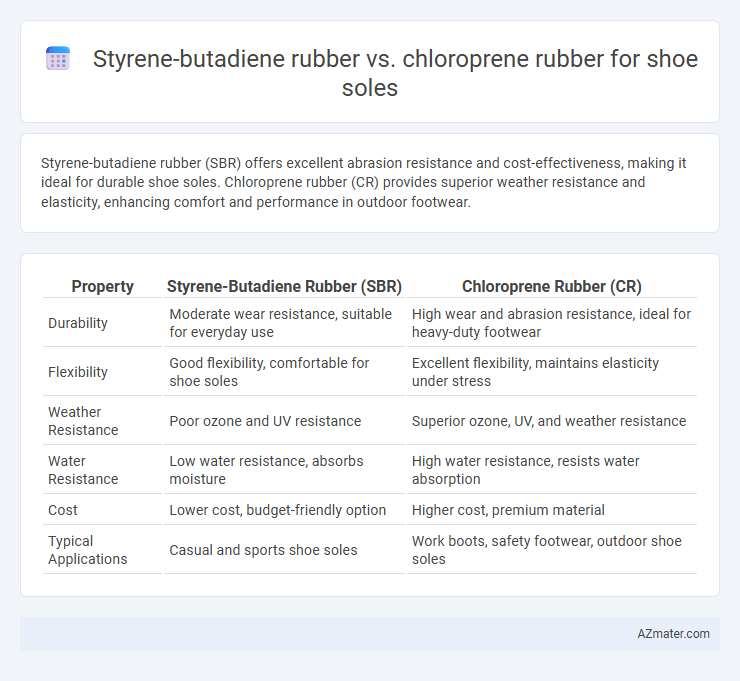Styrene-butadiene rubber (SBR) offers excellent abrasion resistance and cost-effectiveness, making it ideal for durable shoe soles. Chloroprene rubber (CR) provides superior weather resistance and elasticity, enhancing comfort and performance in outdoor footwear.
Table of Comparison
| Property | Styrene-Butadiene Rubber (SBR) | Chloroprene Rubber (CR) |
|---|---|---|
| Durability | Moderate wear resistance, suitable for everyday use | High wear and abrasion resistance, ideal for heavy-duty footwear |
| Flexibility | Good flexibility, comfortable for shoe soles | Excellent flexibility, maintains elasticity under stress |
| Weather Resistance | Poor ozone and UV resistance | Superior ozone, UV, and weather resistance |
| Water Resistance | Low water resistance, absorbs moisture | High water resistance, resists water absorption |
| Cost | Lower cost, budget-friendly option | Higher cost, premium material |
| Typical Applications | Casual and sports shoe soles | Work boots, safety footwear, outdoor shoe soles |
Introduction to Styrene-Butadiene Rubber (SBR) and Chloroprene Rubber
Styrene-butadiene rubber (SBR) is a synthetic polymer known for its excellent abrasion resistance and cost-effectiveness, making it a popular choice in shoe sole manufacturing for durability and wear resistance. Chloroprene rubber, commonly known as neoprene, offers superior chemical stability, weather resistance, and flexibility, providing enhanced performance in demanding environments. Both materials serve critical roles in footwear, with SBR excelling in cost-sensitive applications and chloroprene favored for shoes requiring resilience against oils, chemicals, and extreme conditions.
Material Composition and Chemical Properties
Styrene-butadiene rubber (SBR) consists primarily of styrene and butadiene monomers, offering excellent abrasion resistance and good aging stability, making it suitable for durable shoe soles. Chloroprene rubber (CR), also known as neoprene, contains chlorine atoms in its polymer backbone, providing superior oil, chemical, and weather resistance compared to SBR. The chemical properties of CR, such as its inherent flame resistance and resilience to environmental degradation, make it ideal for shoe soles requiring enhanced durability and protection in harsh conditions.
Durability and Wear Resistance Comparison
Styrene-butadiene rubber (SBR) offers higher abrasion resistance and better wear durability, making it ideal for shoe soles subjected to rough surfaces and extended use. Chloroprene rubber (CR) provides superior resistance to oils, chemicals, and weathering, enhancing the shoe sole's longevity in harsher environmental conditions. SBR excels in impact durability and cost-effectiveness, while CR delivers enhanced flexibility and resilience under temperature variations.
Flexibility and Comfort for Footwear Applications
Styrene-butadiene rubber (SBR) offers excellent flexibility and abrasion resistance, making it suitable for durable and comfortable shoe soles that require long-lasting wear and cushioning. Chloroprene rubber (CR), known for its superior elasticity and resistance to oils and weathering, provides enhanced foot comfort and flexibility, especially in footwear exposed to outdoor conditions. Both materials excel in cushioning, but CR generally outperforms SBR in maintaining flexibility under a wider range of temperatures, contributing to improved comfort in diverse environments.
Slip Resistance and Traction Performance
Styrene-butadiene rubber (SBR) offers excellent abrasion resistance and moderate slip resistance, making it suitable for durable shoe soles in casual applications. Chloroprene rubber (CR) provides superior slip resistance and enhanced traction performance due to its inherent oil and chemical resistance, ideal for work or athletic footwear requiring reliable grip on wet or oily surfaces. Comparing the two, CR outperforms SBR in dynamic environments where optimal traction and safety are critical for shoe sole materials.
Weather and Temperature Resilience
Styrene-butadiene rubber (SBR) offers excellent abrasion resistance and performs well in moderate temperature ranges, making it suitable for everyday shoe soles exposed to varied weather conditions. Chloroprene rubber (CR), also known as neoprene, exhibits superior resistance to extreme temperatures, UV radiation, and ozone, ensuring durability and flexibility in harsh weather environments. For shoe soles needing enhanced weather resilience and temperature stability, chloroprene rubber often outperforms SBR in long-term outdoor applications.
Cost-Effectiveness and Manufacturing Considerations
Styrene-butadiene rubber (SBR) offers superior cost-effectiveness for shoe sole production due to its lower raw material and processing expenses compared to chloroprene rubber (CR). Manufacturing with SBR benefits from easier compound formulation and compatibility with standard extrusion and molding equipment, reducing overall production time. While CR provides enhanced chemical resistance and durability, its higher material costs and complex processing requirements often make SBR the preferred choice for budget-conscious shoe sole manufacturing.
Environmental Impact and Sustainability
Styrene-butadiene rubber (SBR) and chloroprene rubber (CR) differ significantly in environmental impact and sustainability, with SBR being petroleum-based and less biodegradable, leading to longer persistence in landfills and greater carbon footprint during production. Chloroprene rubber, while also synthetic and derived from petrochemicals, often involves more energy-intensive manufacturing processes and emits higher levels of hazardous byproducts such as hydrochloric acid, posing greater ecological risks. Sustainable alternatives in shoe sole materials prioritize bio-based or recycled components, as both SBR and CR contribute substantially to microplastic pollution and resource depletion.
Common Industry Uses in Shoe Sole Production
Styrene-butadiene rubber (SBR) is widely used in shoe sole production due to its excellent abrasion resistance, cost-effectiveness, and good aging properties, making it ideal for casual and sports footwear. Chloroprene rubber (CR), also known as neoprene, offers superior chemical resistance, weather durability, and flexibility, making it suitable for specialized footwear such as hiking boots and industrial shoes. Both rubbers are favored in the footwear industry for their unique performance characteristics, with SBR dominating mass-market shoes and CR preferred in high-performance or protective shoe soles.
Final Verdict: Choosing Between SBR and Chloroprene for Shoe Soles
SBR (Styrene-butadiene rubber) offers excellent abrasion resistance and cost-effectiveness, making it a popular choice for durable shoe soles in casual and athletic footwear. Chloroprene rubber provides superior weather resistance, flexibility, and oil resistance, ideal for high-performance or outdoor shoe soles exposed to harsh environmental conditions. Choosing between SBR and chloroprene depends on the desired balance of budget, durability, and environmental exposure, with chloroprene favored for premium, high-stress applications and SBR preferred for economical, everyday use.

Infographic: Styrene-butadiene rubber vs Chloroprene rubber for Shoe sole
 azmater.com
azmater.com